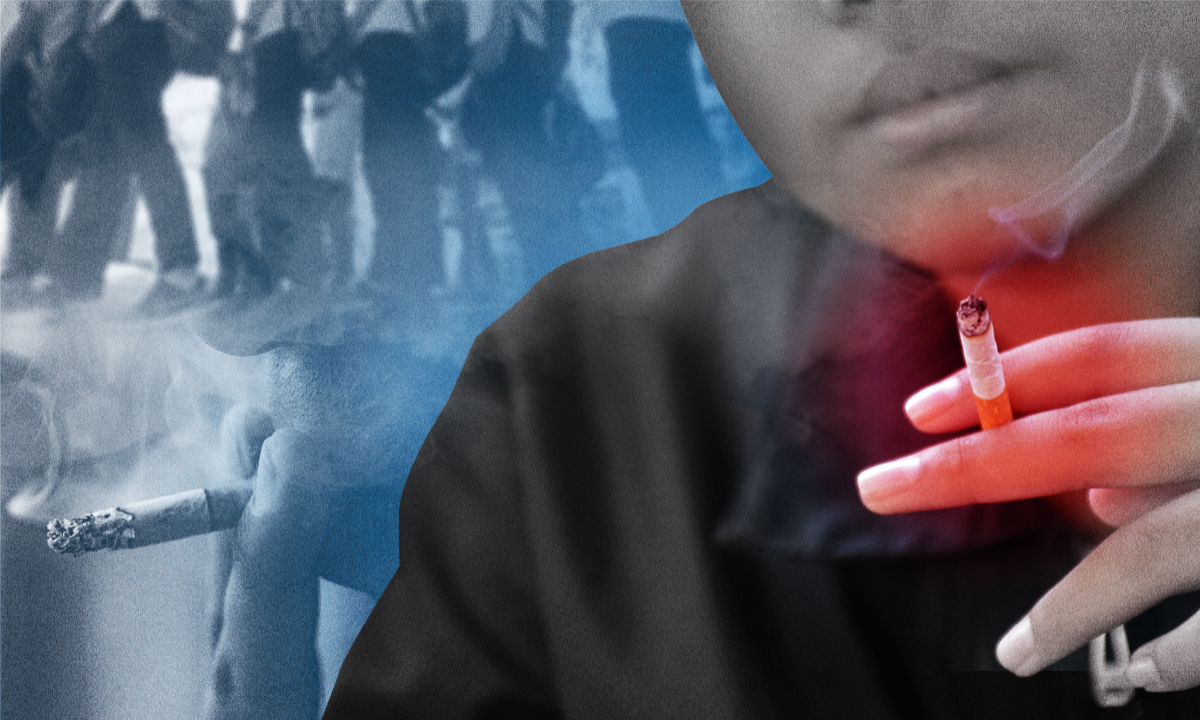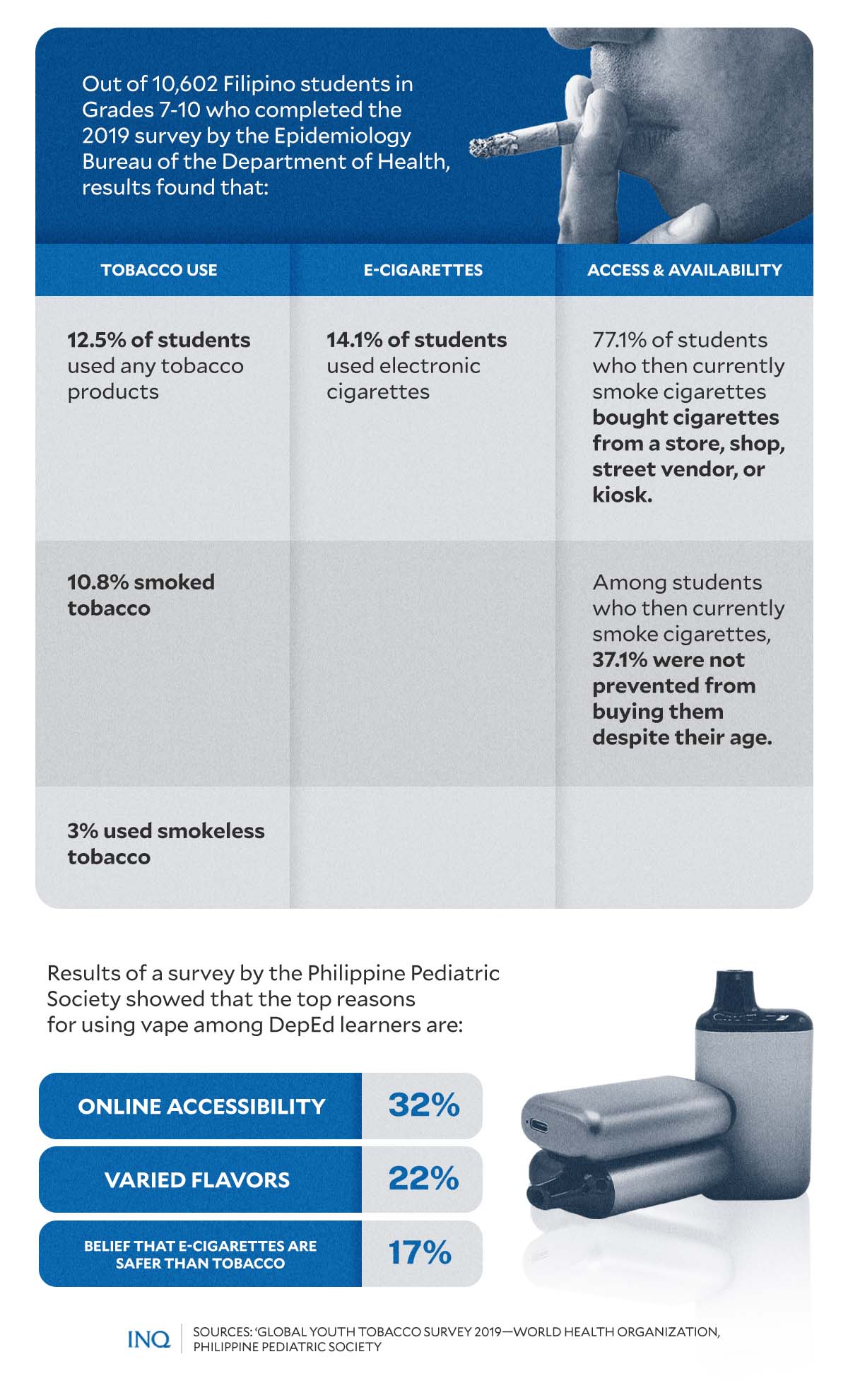Tobacco packaging: Getting PH youth hooked on smoking, vaping
MANILA, Philippines—A study analyzing young adults’ perceptions of various cigarette packaging designs reinforces the case for plain and standardized packaging, to shield future generations and all Filipinos from tobacco-related illnesses and fatalities
Data from the 2021 Global Adult Tobacco Survey showed that 14.4 million, or around 18.5 percent of the adult population in the Philippines, smoke tobacco. At least 11.2 million adults in the country smoke tobacco on a daily basis.
Meanwhile, 13.5 million Filipino adults said they smoke manufactured cigarettes. The figures make the country among the low- and middle-income countries with the highest number of adults who smoke.
Moreover, a 2019 Global Youth Tobacco Survey found that around 11 percent of students in the country smoke tobacco, 10 percent said they smoke cigarettes, and 14 percent use electronic cigarettes (e-cigarettes).
Amid the growing market for tobacco products, specifically e-cigarettes, in the country — targeting both adults and the youth — a study published by the Institute for Global Tobacco Control (IGTC) at the Johns Hopkins Bloomberg School of Public Health and Tobacco Control examined how young adults interpret packaging design of flavored cigarettes.
Article continues after this advertisementA study on tobacco packaging
According to the study, transnational tobacco companies (TTCs) have aggressively invested in increasing tobacco sales in low- and middle-income countries.
Article continues after this advertisementAmong the marketing strategies applied by tobacco companies to further promote their products is through packaging design features, which specifically target young adults who smoke and young people who have recently initiated smoking.
“Packaging is a key marketing tool used by the tobacco industry to promote their products,” the study noted.
“Through packaging design features and appeals (e.g. color, pack shape, the imagery on pack), TTCs target specific consumer groups, associate their brand with core values held by young adults, and influence perceptions of harm, appeal, and expectations about the product,” it added.
To better understand how young adults who smoke interpret packaging design elements of flavored cigarette products, the researchers analyzed several focus group discussions conducted in Mexico and the Philippines.
“Our goal is that findings might inform tobacco control interventions,” the researchers wrote.
Imagery conveys ‘flavor and control’
The study focused on identifying key cigarette pack design features that are attractive to younger people, and the perceptions of pack features that communicate flavor among young adults who smoke.
Results of the focus group discussions showed that young adults who smoke in Mexico and the Philippines similarly described flavored cigarette pack features. The participants in both countries were able to easily identify flavored capsule cigarettes through imagery on packs.
According to the participants, flavor capsules — the crushable gelatine capsule filled with a flavoring liquid embedded into the cigarette filter — are mostly depicted in cigarette packaging of different brands as a “circle,” “dot,” “splash feature,” “bead,” or “pop.”
The researchers also noted that participants also knew that the capsules would release flavors once pressed, “giving them ability to ‘control’ their smoking experience.”
“When you pop it off, it releases the extra flavor,” said one young adult from the Philippines.
Various descriptions of the flavor capsules were also found while comparing responses from participants in Mexico and the Philippines.
“In the focus groups with Filipino participants, flavor capsules tended to be described as ‘cooling’ when smoked,” the study found.
“In the focus groups in Mexico, flavor capsule cigarettes were described as ‘smoother’ than non-flavored cigarettes, which seemed to connote a somewhat different sensation compared with the cooling sensation; yet, both ‘cooling’ and ‘smoother’ were an indication that the harshness of the cigarette was reduced,” it added.
Using colors to identify flavor and entice smokers
Results of the analysis of the focus group discussions also showed that young adults associated pack colors with specific flavors.
“We can also base on the color since the color corresponds with the flavor most of the time,” a Filipino participant said.
“Like the flavorings that already have a predetermined color. You already know that strawberry is pink, red is cherry, mint is blue, that’s what makes you feel like you’re already smoking before you can smoke,” a young adult from Mexico said.
Participants from both countries also stated that the colors used for the packaging increased the appeal of the cigarette pack — especially certain color combinations, blended designs, and vibrant colors.
“The ones we deemed attractive are colorful,” a Filipino young adult shared.
Flavored cigarettes perceived as ‘youth products’
The majority of focus group members from both countries agreed that flavored cigarettes and flavor capsules are mostly used and intended for young people and those who are interested in trying out smoking.
“[A capsule pack] will appeal to millennials,” said a focus group participant from the Philippines.
“The brand is really affordable, but the flavor makes it more appealing to the younger ones,” another Filipino young adult responded.
The researchers noted that flavored cigarettes, considering the packaging designs, might be contributing to smoking initiation among young adults.
They added that the findings of the study support the implementation of plain and standardized packaging, product display ban at the point of sale, and bans on flavored tobacco, including flavor capsules and other filter innovations.
Last year, when the hotly debated Vape Bill passed in both the House of Representatives and the Senate, health experts who sought to veto the bill said that while flavors and additives used in e-cigarettes and vapor products might not have a direct impact on health, they will entice more non-smokers, particularly the youth.
“The flavors, that’s why we don’t want them. It’s not because of the injury, it’s because it entices children, it was developed for kids. Because no adult will smoke blueberry flavor or ice cream,” Dr. Rolando Enrique “Eric” Domingo, former director-general of the Food and Drug Administration (FDA), told VERA Files.
“By lowering the age of access to vapor products from 21 to 18 years old, allowing flavorings, and permitting advertising and sponsorship strategies, the bill, when passed into law, will expose our youth to harmful and addictive substances by making vapor products enticing and easily accessible,” the health department added.
Read more: As Duterte action awaited on Vape Bill, experts paint grim scenario for PH youth
Data from the Philippine Pediatric Society showed that 11 percent of students aged 10 to 15 years old have already tried vapes. The Department of Education (DepEd) likewise reported that 6.7 percent of Grades 7 to 9 students were found to “have tried and are using e-cigarettes.”
Among the top reasons for vape use among students were online accessibility (32 percent), varied flavors (22 percent), and the belief that e-cigarettes are safer than tobacco (17 percent).
“We can see here that in terms of how attractive these vapor products or heated tobacco products are…it’s meant to attract the youth. That’s not actually contributing to lessen the harm of these products, it actually increases it,” said Dr. Boss Sobremesana, medical officer of the DOH Health Promotion Bureau.
Push for plain packaging
A separate paper published by the Tobacco Control and Governance Program at the Ateneo School of Government (ASOG) examined the perception of Filipino smokers on the impact and effectiveness of plain packaging of tobacco products.
The study titled “Opportunities for Plain Packaging of Tobacco Products in the Philippines: Results of a Nationwide Online Survey,” based on a nationwide survey of 2,000 Filipino adults aged 18-65 years old, found that Filipinos are ready for plain packaging of tobacco products.
“They believe it will make health warnings on tobacco products more effective, reduce their attractiveness, eliminate misleading information, and increase the noticeability and effectiveness of health warnings,” the study noted.
“[P]olicymakers should clearly identify features of packaging to be standardized, features of packaging to be prohibited, and features of products to be standardized in tobacco packaging in the Philippines,” the researchers stressed.
The study also added that plain packaging should cover all tobacco products — including heated tobacco products, vaporized nicotine, and non-nicotine products — that are available for sale in the Philippines.


